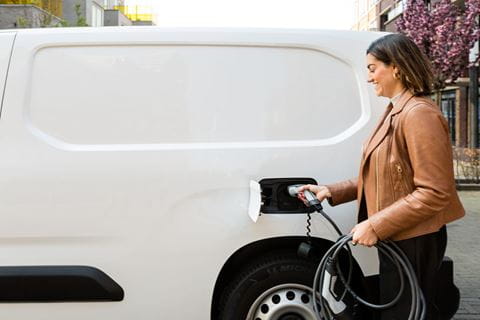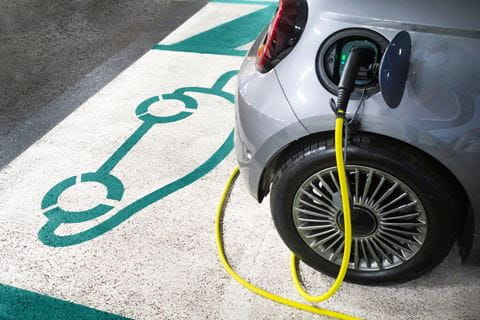
EV home charging
Good to know and solutions that we offer
Charging at home is a convenient way to reduce your charging expenses. On this page, you’ll find plenty of useful information on how to get started with home charging, as well as what we offer in terms of home charging solutions.
Norgespris
With Norgespris, you get an electricity price you can rely on – all year round. From October 1, 2025, through the end of 2026, the price is set at 50 øre per kWh, incl. VAT. The next price adjustment will take place on January 1, 2027. The scheme applies to electricity for both homes and holiday properties, and is funded by the Norwegian government. The goal is simple: to give people predictability and peace of mind in their everyday lives. Norgespris is not a new fixed-price agreement in the consumer market, nor is it a contract with the government for electricity delivery. It’s a scheme designed to make planning – and living – a little easier.
- Good to know about home charging
A dedicated charging box is the only legal way to charge your electric car at home. The “charging brick” can pose a safety risk and should only be used for emergency charging. Installing a regular power outlet for EV charging is not permitted.
How long does it take to charge an electric car
7.4 kW power output
- 50 kWh EV battery7h45m
- 75 kWh EV battery10h
11 kW power output
- 50 kWh EV battery5h15m
- 75 kWh EV battery6h45m
50 kW power output
- 50 kWh EV battery53 min
- 75 kWh EV battery1h20m
150 kW power output
- 50 kWh EV battery18 min
- 75 kWh EV battery27 min
What does battery capacity mean in an electric car?
Battery capacity tells you how much electricity your car can store. It’s measured in kilowatt-hours (kWh). Think of it like the fuel tank in a regular car: the larger the battery capacity, the farther the car can drive before needing to charge. A 90 kWh battery can theoretically deliver 90 kW for one hour, or 30 kW for three hours, and so on.
- Important to know
Bigger battery = more range, but often also higher cost and weight. How far you actually get also depends on driving style, temperature, load, and terrain.
Gross vs. Net Battery Capacity
If you see that a battery has a high total gross capacity (kWh), it doesn’t necessarily mean you can use all of it. Batteries always include a buffer capacity to help protect battery health. The portion of the battery you can actually use is called the net capacity – or usable capacity.
| Term | What does it mean? | Example (BYD Sealion 7) |
| Gross | The total battery capacity the car has | 91,3 kWh |
| Net | The usable capacity you actually get | around 85–88 kWh (depending on car) |
| Term | What does it mean? | Example (BYD Sealion 7) |
| Gross | The total battery capacity the car has | 91,3 kWh |
| Net | The usable capacity you actually get | around 85–88 kWh (depending on car) |

Home charger for business customers
If you’re driving a company car from us and your employer covers all or part of the cost for a home charger, we can order a home charger from Laddel or Circle K.
Home charging for private customers
We currently do not offer home chargers or installation to private customers – our charging solutions are only available to corporate customers with company cars.
If you’re looking for a home charging solution, we recommend contacting a certified electrician or an independent provider of charging solutions. There are several companies in the market offering complete packages that include both the charger and installation – for example, well-known electrical installers or specialized charging providers.
New standards for the installation of charging points
'The change in NEK 400:2022, effective from July 1, 2022, pertains to electrical low-voltage installations. It entails that it is no longer possible to install a grounded household outlet for daily or regular electric car charging purposes.
This means that if charging is the purpose of the installation, you must install a charging box with a Type 2 connector.
A charging box or charging station is the only safe and legal alternative because it eliminates misuse and provides additional safety margins. It also allows for faster charging if your power system has sufficient capacity. To determine the charging power you can get, this is something you need to check with an electrician.
The "old-fashioned" way of charging the electric car through the so-called "Schuko" outlet is no longer a legal way to charge your electric vehicle. This is because electric cars require stronger residual current devices. To explain what the "Schuko" is, it's usually the bulky charger that connects to the car and a standard household outlet. Charging through such an outlet, especially if the electrical wiring is old or too weak, can lead to overheating or even a fire. According to the Directorate for Civil Protection and Emergency Planning (DSB), charging with the "Schuko" outlet is only allowed for emergency situations.
Here's what you should follow if you need to "emergency charge":
- The outlet should be on a separate circuit.
- The circuit should be rated at a maximum of 10 amperes.
- It is required to have a type B residual current device.
- The charging box should hang on a hook to avoid damage from the weight.
- The cable and connector should be regularly checked for overheating.
- Avoid using extension cords as this can lead to overloading, short circuits, insulation damage, and electric shock.
Can I install a home carger?
Rented home
Contact the landlord and check what the possibilities are. Many home associations have home charger deals.
Home without fixed parking spot
Find your closest public charging spot here.




